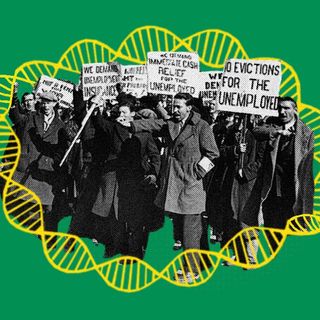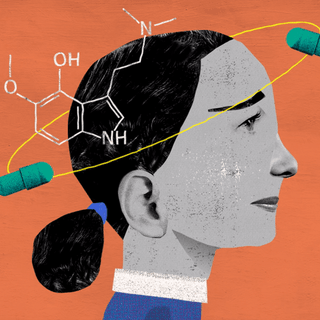
Hoarding Disorder is on the Rise. Is Capitalism to Blame?
Hoarding highlights our complex relationship with material possessions – shaped by a capitalist culture that perpetuates increased consumption of goods.

After the death of Aakriti’s* mother, she and her sister unearthed a plethora of suitcases full of plastic packets stacked in her loft and under her bed. “[We] would keep telling her to throw it away. But she would get upset and say ‘No, I need it,’” Aakriti, 54, says. Plastic packets weren’t the only things Aakriti’s mother found difficult to discard. Decades-old soaps, boxes, rusted keys with no locks, broken pencils and pens that had long dried out are some of the other knick-knacks that cluttered her space.
Hoarding is understood as the persistent difficulty in discarding possessions, irrespective of value or functionality, leading to disorganized clutter that affects the quality of life of the individual. In 2013, this compulsion, in its most debilitating form, was formally recognized as hoarding disorder in DSM-5.
Hoarding also highlights our complex relationship with material possessions – one that is shaped by a capitalist culture that perpetuates and profits from increased consumption. Citing a rise in cases of hoarding in the US, a 2021 article in Jacobin noted that capitalism may lie at the root of hoarding, as it “creates simultaneous conditions of scarcity and surplus — a fundamental condition of dispossession, and endless possessions to fill the void.” The capitalist economic system, thus, is built upon creating a need where there is none.
This instinct to accumulate goods seems to have passed down to Aakriti from her mother. From books and artifacts to medicines, all kinds of objects clutter every available surface in her house. “Sometimes you start feeling guilty about the fact that you have so much stuff. But I need these things,” she says.
Hoarding disorder is a common condition and cases are steadily increasing in the West, wrote Dr. Karen Stollznow in Psychology Today, pointing out that the effort to protect oneself from an uncertain future may be behind the rise in hoarding behavior. This uncertainty also speaks to the interplay between the perceived need for and lack of items and resources.
Related on The Swaddle:
Why Do Some People Hoard Things?
Several reports have pointed out how capitalism is bringing about greater social isolation and loneliness, as our time, productivity, and energy is directed towards maintaining the system. It creates competition among people, decimates the foundations of relationships, and births insecurities. This social isolation, and the resulting need for external security, then lead to people developing unhealthy attachments to possessions.
“When our need isn’t met by humans, objects may serve as a substitute,” stated an article in The Conversation. Individuals who hoard often experience interpersonal difficulties that lead them to anthropomorphize objects to compensate for their unmet social needs, it explained. “Stronger anthropomorphic tendencies are associated with more compulsive buying and greater acquisition of free stuff.”
This attachment to objects, for hoarders, may become more valuable than their relationships with people, leading to intense emotional distress at the prospect of parting with them. One study explored how objects one owns are seen as an extension of the self, the loss of which may be perceived as a threat to self-identity. Monetary value does not play a significant role here – what matters more are the experiences attached to the objects.
Aakriti adds that beyond the sentimental value of objects, “I feel that I am not the sole decider because maybe the next generation might also have some value or use for that thing. It’s not only yours to throw away.”
According to an article in Psychology Today, hoarding could also arise from past traumatic experiences, where compulsive shopping and the need to retain objects become a coping mechanism to deal with grief, loss or even posttraumatic stress. “The more hoarders accumulate, the more insulated they feel from the world and its dangers. But of course, the more they accumulate, the more isolated they become from the outside world, including family and friends,” wrote psychologist Dr. Gregory Jantz.
Who hoards, and why, also become central questions to not only understand this behavior but also its possible links with privilege. A 2008 study that looked at the prevalence of hoarding in association with household income found that the “odds of hoarding was over 4 times as great in the poorest, compared to the wealthiest, households.” Experiencing a lack of necessary resources may lead to a “pathological desire to save things one may someday need, even if it’s impossible to say why or when,” noted the Jacobin article.
The luxury of space is another way privilege intersects with the experience of hoarding. “If I was living in a big, posh house and had this amount of books on the shelves, they would call it a library… But because I’m living in a bungalow and I’m the underclass, I’m a hoarder,” David Woods, a council worker, told The Guardian.
Moreover, as technology continues making inroads into our daily lives, hoarding is no longer limited to physical items. Earlier this year, researchers proposed the idea of “digital hoarding.” Such instances of hoarding behavior might be familiar to many of us – unread newsletters piling up in our inboxes, screenshots of webpages we believe we must archive, images and videos that we may never revisit but that immortalize memories in the cloud, simultaneously eating up storage space.
In an article in The Conversation, the researchers pointed out that digital hoarding might escalate faster than the physical accumulation of goods, as space limitations online are not immediately visible, and can easily be expanded for a fee. The ease of storing large amounts of information online may also obscure the fact that our use of technology is monopolized by platforms today, whose profits hinge on the commodification of our lives in the form of data – a central tenet of digital capitalism.
Despite its growing prevalence due to the digital era, hoarding has been historically dismissed as laziness and untidiness, which ignores the mental health implications and acute distress that accompany it. Further, while awareness has grown significantly in the West, a 2021 paper noted that there is still little data on its prevalence in low- and middle-income countries, underlining the need for improving both awareness and detection.
Related on The Swaddle:
As a mental health condition, hoarding is a difficult problem to address. Many hoarders may be reluctant to seek treatment or not recognize they have a problem to begin with. Therapy, medication, and support groups are some common ways that this compulsion is being treated. However, most continue to “suffer in silence” due to embarrassment or guilt associated with their clutter.
Further, Kaila Bolton, a filmmaker and visual anthropologist, wrote that while medicalization is important, it also places the burden of addressing the issue on hoarders as individuals. “In doing so, it absolves our societies of collective responsibility for having created, and for perpetuating, the conditions in which this type of behavior emerges and exists.”
Hoarding then must be viewed within the larger socio-cultural environment that pushes the accumulation of excess, especially in times of socio-economic uncertainty. As cases reportedly rise in the West, hoarding has become a growing concern to the psycho-social well-being of many who suffer its negative impacts. Its intersections with our capitalist culture make this behavior more complex to treat, as our underlying system exacerbates the compulsion, allowing what can quickly become detrimental, to flourish.
*Name changed upon request
Ananya Singh is a Senior Staff Writer at TheSwaddle. She has previously worked as a journalist, researcher and copy editor. Her work explores the intersection of environment, gender and health, with a focus on social and climate justice.
Related


There’s Still No Scientific Consensus Linking Serotonin With Depression. Why Did the Theory Get So Popular?
